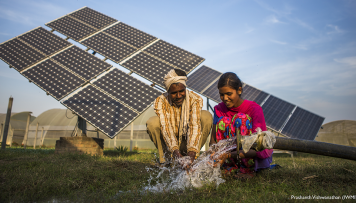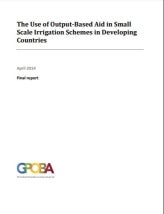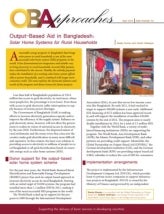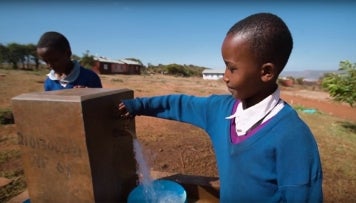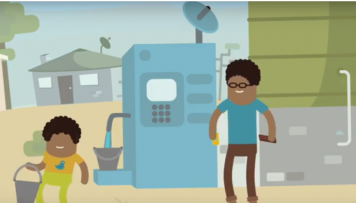
Image: World Bank Water Blog
Filling one bucket is easy. Filling buckets of water for an entire rural village is doable. But ensuring clean water for an entire sub-Saharan country can prove difficult.
There are two fundamental reasons why half of the rural population in many sub-Saharan countries lack access to safe water. First, rural water systems break down frequently. Second, rural water systems are expensive. These seemingly simple reasons mask a remarkably complex reality. That’s because a body of evidence points to a multitude of challenges affecting the sustainability of rural water supply. This includes funding, where the combined financing capacity of donors and governments is far outstretched by the resources required to close the existing funding gap. In the meantime, thousands of rural villages lack safe water. This begs the question: what should a deep-well rural water system look like in the future? How will it avoid breaking down? And perhaps more importantly, how should it be financed? A new model in Tanzania is experimenting with a bold solution combining blended financing with emerging technologies (Watch the video Financing + Sustainability = The Future of Rural Water Systems to learn more).
Addressing Sustainability of Rural Water Supply
Achieving sustainability involves perfecting a range of complex issues. The advancement of technology, the Internet of Things and its increasing affordability and applicability allow for a range of improvements potentially favorable to sustaining rural water schemes. Remote monitoring of pumping systems is now widely available and allows operators to remotely monitor and troubleshoot pump performance and groundwater levels. Solar pumping significantly reduces the cost of water extraction and could potentially return financially struggling village water utilities back to profitability.
Rural communities may not always have the full capacity to service and maintain modern pumping systems, and the private sector has traditionally only been involved during the construction phase. However, what if contractors were obliged to commit to a four-year service agreement, including extended warranties through the so-called “build and operate” contracts enforced by a performance bond? Such long-term contracts are often expensive due to the remoteness of rural villages. Nevertheless, economies of scale in the provision of service and maintenance could be achieved by clustering 50 villages within the same proximity and awarding the works and service provision to just one contractor. This approach would further benefit from standardization of equipment, remote sensing of all 50 sites, and the long-term sustainability enhanced by an option for the participating villages to extend the service contract beyond the initial four-year service period.
Closing gaps and financing taps
While the above mentioned model may contribute to the sustainability of rural water schemes, the financing gap in the sector is perhaps the largest obstacle to achieving the Sustainable Development Goal 6- Ensure availability and sustainable management of water and sanitation for all. Closing this financing gap has historically been a tall order for government and donors, especially considering that about one-in-five newly constructed water schemes breakdown within the first few years. Taking Tanzania as an example, let’s presume that there are 6,000 rural villages without access to safe water. And for argument’s sake, let’s assume that a new rural water scheme for 3,000 people costs US$ 100,000 leaving an investment gap at US$ 600 million for new rural water schemes (discounting the rehabilitation needs of existing water schemes and the need to expand existing schemes to meet the demand of the growing population). In summary, there is a dire need for rethinking the traditional financing model for the rural water sector.
A New Model - “Accelerating Solar Water Pumping via Innovative Financing”
This project in Tanzania combines the above mentioned technologies and approaches and targets existing rural water schemes powered only by diesel generators and where water customers are used to pay for water. The pilot seeks to demonstrate that rural communities can repay 40% of the capital investment and maintenance service contracts without increasing the price of water. The 40% will be financed through a four-year loan from the TIB Development Bank. The other 60% will be subsidized through a grant funded by SIDA and the Dutch Government through the World Bank’s Global Partnership for Results-Based Approaches (GPRBA). The pilot also received assistance from Global Water Security and Sanitation Partnership.
The benefits from this initiative are two-fold. Firstly, it harnesses the power of private sector financing in community development through blended subsidy-loan combinations. Secondly, transitioning from diesel pumps to solar pumps with demonstrable environmental and economic advantages in the form of lower CO2 emissions and high life-cycle cost savings.
Collecting monthly revenues from rural remote villages poses obvious challenges. Mobile-money-enabled pre-paid water dispenser technology has been around for about a decade. The price was previously prohibitive for mainstreaming, but recent pilots in East-Africa have demonstrated that it is dropping rapidly. By digitizing revenue collection to a ring-fenced bank account, this technology has anecdotally increased revenue collection by 50-400% in remote rural villages in Tanzania.
Over the next two years, the project will find out whether this new model will create the envisioned synergies. A successful pilot could be transformational in that the loans could be extended from four years to possibly 15-20 years, potentially enabling the communities to cover a larger portion of the capital investment of their water scheme while keeping the price of water constant, thereby helping bridge the financing gap.
We are entering a period where sound financial engineering is just as important as civil engineering, and closing the financing gap will open new opportunities for reaching the SDGs .
(originally appeared as a blogpost on the World Bank's external website).



